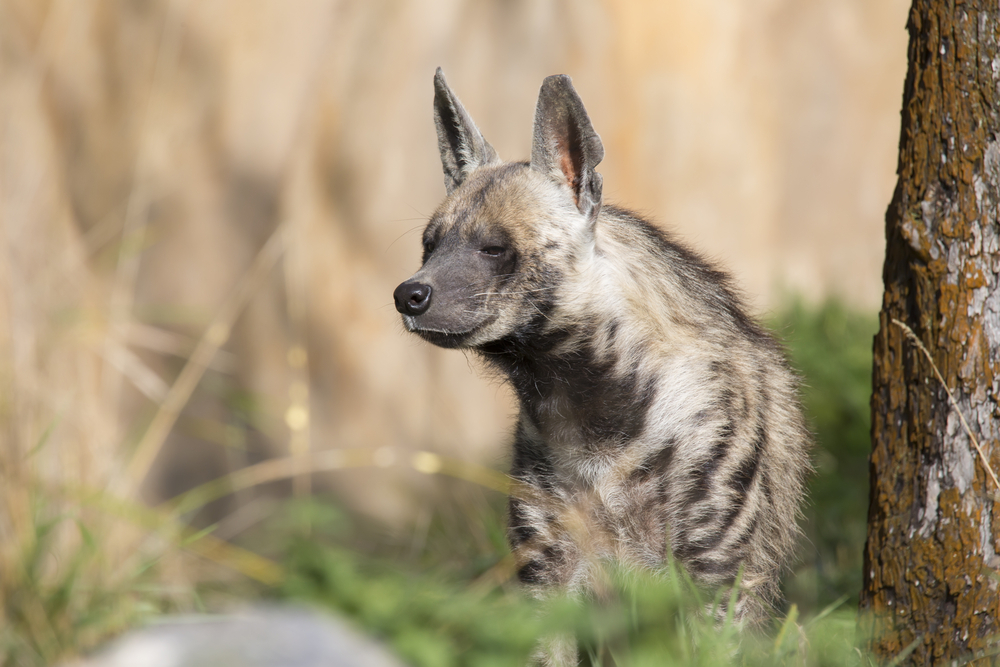
Wolves and hyenas—two species of opportunistic carnivores infamous for their ruthless predatory instincts— are highly unlikely bedfellows, but evidence unearthed in Israel’s Negev Desert and recently published in the journal Zoology in the Middle East, has revealed that the two species can travel and work together in order to survive in some of the world’s harshest environments.
The southern Negev is a brutally tough place to eek out a living. Temperatures are extreme, rainfall is rare and food is perpetually on short supply. Of all places, this is where you might expect to see cruel evidence of Darwin’s theories of survival being brutally acted out. Instead, two respected scientists have observed clear evidence of at least one striped hyena roaming and hunting together in a mixed pack with grey wolves.
Lead author of the new study, Vladimir Dinets, who studies behavioural ecology and evolution at the University of Tennessee, concedes that this is a massive shock, noting that hyenas are known to fight fellow predators, including dogs and large cats such as cheetahs and even lions, and will even kill the cubs of other carnivores for a quick meal. Wolves, too, are not known for their cross-species sociability traits, and have also been observed killing coyotes, lynxes and dogs.

Dinets found the first evidence of the surprising alliance in 1994, when he stumbled on a set of footprints, mixed wolf and hyena tracks, in the desert near Eilat.
‘Remarkably, in many places the hyena tracks were on top of wolf tracks, but in other places the sequence was the opposite,’ he explains in the report. ‘The tracks of the three wolves also overlapped each other in all possible orders, indicating that the tracks of all four animals were left at the same time and that the hyena was sometimes following the wolves and sometimes was being followed by at least some of them.’
Four years later and over 2000km away, that theory was backed up by visual evidence gathered by Dinets’ co-author, Israel-based biologist Beniamin Eligulashvili. Just after after sunset during a field trip, Eligulashvili and two other researchers spied a mixed pack of animals comprised of seven grey wolves (four adults and three younger animals) and one striped hyena. ‘The animals were observed for 2–3 minutes as they climbed up the wadi slope, repeatedly stopping to look back at the car,’ the researchers write. ‘The hyena was not following the wolves, but moving in the middle of the pack.’

This was a slap in the face for everything behavioural biologists thought they knew about striped hyenas, who are typically even more solitary than their more social relatives, the spotted hyena. It was so surprising that the scientists held off publishing their study until now, hoping in vain to capture more evidence of the rare behaviour.
So, how could this happen? There are several possible scenarios going on. This could be a single rogue hyena, acting in a highly unusual fashion, or it could be a case of longterm kleptoparasites, with the animal trailing the wolves and feeding off their leftovers—but neither of these suggestions would account for the wolves’ tolerance of a rival species in their midst. As the researchers rhetorically ask,’Why did the hyaenas move in the middle of the packs, and the wolves tolerate them?’
The third theory is almost incredible, and yet increasingly seems the most likely explanation. Dinets and Eligulashvili have suggested that the animals have established a symbiotic relationship, a way of working that’s mutually beneficial. ‘The hyaenas could benefit from the wolves’ superior ability to hunt large, agile prey,’ they explain. ‘While the wolves could benefit from the hyenas’ superior sense of smell and their ability to break large bones, to locate and dig out fossorial animals such as tortoises, and to tear open discarded food containers such as tin cans.’
Dinets says that the findings not only represent a revelation in our understanding of two species, they also contain lessons for mankind. ‘Animal behaviour is often more flexible than described in textbooks,’ he says. ‘When necessary, animals can abandon their usual strategies and learn something completely new and unexpected. It’s a very useful skill for people, too.’
